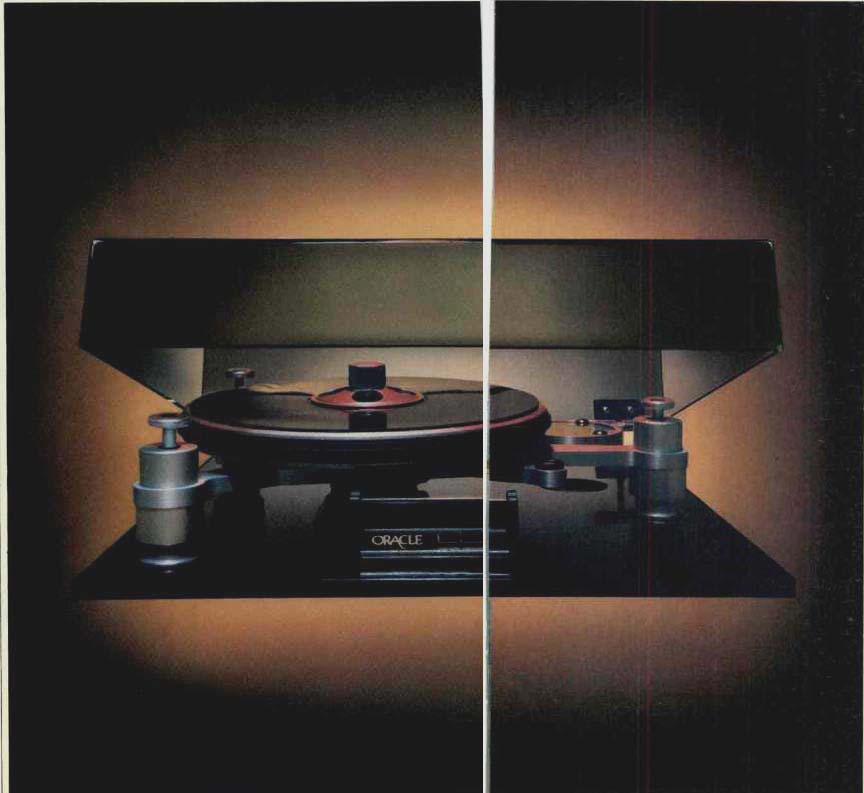
Manufacturer's Specifications:
Speeds: 33 1/3 & 45 rpm.
Selector Method: Pushbuttons.
Motor Type: 24 volt d.c., Hall effect.
Motor Mounting: Direct to main chassis, isolated from subchassis.
Drive System: Belt.
Bearing: Tungsten carbide.
Suspension: 3 tapered springs.
Platter Diameter: 11 7/8 inches.
Platter Weight: 6 lbs. (2.7 kg).
Platter Material: Magnesium alloy.
Tonearm: Not supplied.
Dimensions: 19 in. (482 mm) W x 14 1/2 in. (368 mm) D x 6 1/4 in. (158 mm) H.
Total Weight: 22 lbs. (1 0 kg).
Power Required: 100-130 V a.c. 50 60 Hz.
Ground Wire: None.
Price: $1,095.00.
In recent years, it has been shown that turntables greatly affect sound quality, but correlating sonic performance with lab oratory measurements still needs much experimentation. Conceptually, a turntable that contributes little coloration or distortion to the reproduced sound should present a difficult measurement problem, and the Oracle does exactly that, thus deserving its reputation for high performance capability.
The Oracle's appearance suggests, and its performance verifies, that it is not an ordinary turntable. The suspension towers, which support a skeletal subchassis, combined with the smoke-colored main support chassis and the hinged dust cover, impart a distinctive appearance. The attention to detail and care of finish, and even the well-designed protective packaging, exhibit a substantial amount of pride in manufacture.
Each of the three support towers (shown cut-away in Fig. 1) encloses a spring of a different stiffness. The reasoning here is that since the mass of the turntable and tonearm are distributed unevenly, the stiffness of each support should be different.
When the proper springs are used, the whole subchassis, platter and tonearm should move up and down evenly, without rocking motion or rotational modes.
Figure 2 shows the unusual design of the subchassis-a seven-layer laminate consisting of four layers of magnesium-aluminum alloy separated by three layers of a special bonding substance, which absorbs internal vibrations. The tonearm mount is a round acrylic disc which can be changed for different tonearms without much difficulty. The manufacturer recommends that the tonearm be fastened securely to the platform without any compliant interface, such as a rubber washer, be tween them. When the record is clamped firmly to the platter (as it is with the Oracle system) and the phono cartridge is mounted in a stable tonearm with good bearings, the whole assembly moves together as a unit, which is as it should be. I used The Arm from Sumiko for testing.
--------------MEASURED DATA------------
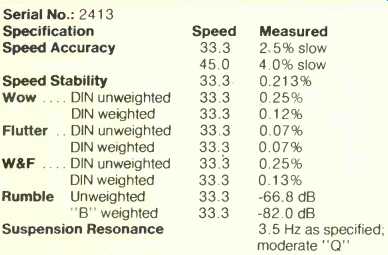
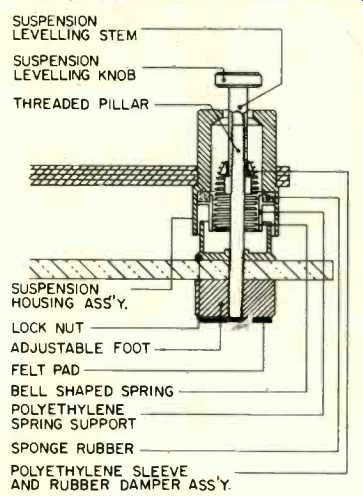
Fig. 1--Cut-away side view of one suspension tower, showing detail of spring
mounting.

Fig. 2--Side and top views of the subchassis show the unusual design and construction.
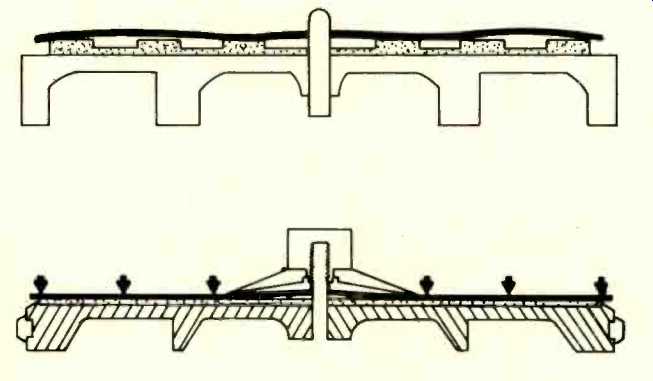
Fig. 3--Top, warped record on an ordinary platter; bottom, clamp system used
in the Oracle.
The Oracle incorporates other interesting features which are designed to achieve what Trans Audio calls Groove Isolation. Part of this isolation is accomplished by clamping the record to the turntable mat with a screw-down clamp, as shown in Fig. 3, which allows dish-warped records to be flattened and fastened securely. The mat is made of a special composition designed to absorb mechanical vibrations from the record. These vibrations, a result of the stylus interaction with the record groove, have been largely ignored until recently. Such vibrations travel back and forth within the record, forming delayed reflections of mechanical energy, which, if not damped quickly, are picked up by the stylus and blur the detail of reproduced sound.
Another source of unwanted mechanical energy is caused by the normal bell modes of a turntable platter. To absorb this energy, the outer rim of the Oracle's platter has a band of relatively hard rubber the firm calls a Peripheral Wave Trap. My experience with damping the vibrational modes of loudspeaker diaphragms has taught me that this is an excellent way to deal with turntable platter resonances and, indeed, the Oracle has the deadest platter of any I have tested.
The Oracle's unweighted rumble was -66.8 dB below the 10-cm/S lateral groove modulation reference. The rumble using DIN "B" weighting was -82 dB. Since this rumble figure is an average value of all the spectral components up to 500 Hz, two turntables could have the same rumble figure and still have different sonic characteristics. The spectrum of the Oracle's rumble is shown in Fig. 4. The spike in the center, where the cursor is set, is at 18.75 Hz, and the rumble measures -41.9 dB at this frequency. The peak may be due partially to the B&K 2010 test record. In general, rumble measurements are difficult because they are limited by the rumble cut into the grooves of the test disc. The computer-controlled Nicolet 660-2D FFT spectrum analyzer, which was used to make all the 'scope photos and measurements shown, allows a sufficiently detailed analysis to check even the 50-Hz powerline hum, which was measured as-50.3 dB. (This test disc comes from Europe, where the a.c. powerline frequency is 50 Hz.) Analysis of Fig. 4 revealed that the Oracle has very low rumble with the major contribution below 20 Hz, a desirable condition.
The wow-and-flutter meter readings, using the DIN Standard, were 0.25% unweighted and 0.13% weighted. Readings for wow alone were 0.24% unweighted and 0.12% weighted; for flutter alone, readings were 0.07% both weighted and unweighted. Figure 5 displays the spectrum of wow components between 0.125 and 50 Hz. The cursor is set at 0.5 Hz and the next major spike is at 1 Hz; these two frequencies relate to full and half platter rotations at 33 1/3 rpm. This cyclical variation results from the difficulty inherent in making a perfectly concentric record and then getting the hole precisely in the center. For these tests I adjusted the disc until this variation was at a minimum. A very noticeable reduction in the 0.5-Hz component occurs when this is done, and the contribution to wow caused by record warp for the 4- to 10-Hz range is more apparent.
The Oracle's lack of flutter was readily noticed by the people who auditioned it during a long series of comparisons with other fine turntables. It was particularly easy to hear when we used a recently released Sonic Arts piano recording, Lab 16, which was mastered digitally. This recording's lack of scrape flutter (usually encountered with analog tape recorders) allowed the intrinsic flutter caused by the different turntables to be easily heard as more or less blurring of detail in the reproduced sound.
Absolute speed stability, while quite good in the Oracle, was not exceptional, but this affects sonic performance less than wow and flutter, rumble, or groove-to-groove isolation does. Figure 6 shows the range of speed drift for 16 samples over a 20-second period. The cursor is centered on the 3150-Hz tone of Band 8 of the B&K 2010 test record. The display is calibrated to show 8 Hz per horizontal division and a total window width of 80 Hz. The drift in speed was ±0.213%. Another more commonly used method of displaying speed drift is shown in Fig. 7, a 40 second recording taken from a wow-and-flutter meter. This measurement indicates the somewhat random, low-frequency nature of the drift. During the listening sessions, no comments were made which could be connected directly with the Oracle's speed stability, even when listening to piano recordings which are very good for revealing pitch variation.
The importance of Fig. 8A lies in what it doesn't show. The average level of background noise from the B&K 2010 test record is about -75 dB. There is no indication of any spectral contribution between 200 Hz and 5 kHz from the Oracle, which is as it should be. Figure 8B displays the spectrum from 0.5 to 200 Hz and indicates how good the signal-to-noise ratio remains at the lowest frequencies of interest. The main bump in this spectrum is due partly to tonearm resonance.
I also measured the signal-to-noise ratio with the Thorens Rumpelmesskoppler method. The S/N ratio improvement, shown in Figs. 9A and 9B, is 3 to 4 dB over the results using the B&K 2010 test record. One listener commented on the apparent reduction of background noise when the same record was switched to the Oracle after being played on another turntable. Groove Isolation apparently causes an audible improvement in the background noise level.
The effectiveness of damping the turntable platter resonance with the Peripheral Wave Trap is shown in Fig. 10. I removed the record mat during this test and placed the stylus tip on the metal platter at a distance of approximately 5 1/4 in. from the spindle before applying a series of eight mechanical impulses to the upper edge of the platter rim and obtaining the average. Then I monitored the uniformity of the spectral content for each impulse and verified the repeatability of these measurements.
The important results of this test lie within the frequencies where energy is concentrated. Absolute level is related to the level of the input impulse and, therefore, is of secondary significance. The relative level among various frequencies, however, is of interest and shows that energy in the platter is concentrated at 550 Hz, 600 Hz, 1100 Hz, 1625 Hz (cursor position), and 2000 Hz. The data in Fig. 10 compare most favorably with results from other turntables. The natural resonances of the Oracle's platter are damped very well, even without the record mat in place.
For the next measurement, I placed the record mat on the platter, clamped a standard record in place, and positioned the stylus tip in a quiet groove at the inside diameter of the record.
Leaving the turntable stationary, I applied the same mechanical impulses to the rim of the record. Both channels were monitored on the Nicolet spectrum analyzer, but only one channel is shown in Fig. 11.
The results of this measurement are extraordinary when compared to those obtained from other turntables. The correlation between comments made by all of the people auditioning the Oracle and this objective test seem to be excellent. The uniform distribution of spectral components is amazing. Listeners re marked about clarity and realism in the reproduced sound, especially noting how the timbre of individual instruments seemed so well defined. These comments can be traced directly to the Oracle's control of extraneous spectral energy in the record which can otherwise blur such detail. Additional listening tests, conducted with the clamp partially released and with the clamp and domed washer completely removed, revealed a deterioration in this clarity and detail.
I was curious to see if the same improvements could be heard with dbx-encoded records. To find out, I used M&K's RT-202 recording which features Dukas' "Sorcerer's Apprentice" and Chabrier's "Espana." The results were just as significant as those heard with standard recordings. I was not prepared for the substantial differences I heard with different digital recordings. I was surprised to hear a type of defect on some of them which I can only describe as "grunge," and the Oracle allows this defect to be heard quite easily. The M&K recording (digitally recorded with dbx encoding) did not have this "grunge" and sounded excellent. The previously mentioned Sonic Arts Lab 16 also lacked this defect, so I concluded that this particular form of distortion marred some digital recordings, but not all of them.
The Oracle turntable is an excellent choice for people interested in hearing all the detail contained in their record's grooves. I also suspect that Oracle owners will be in the van guard of those clamoring for better record quality.
---Edward M. Long
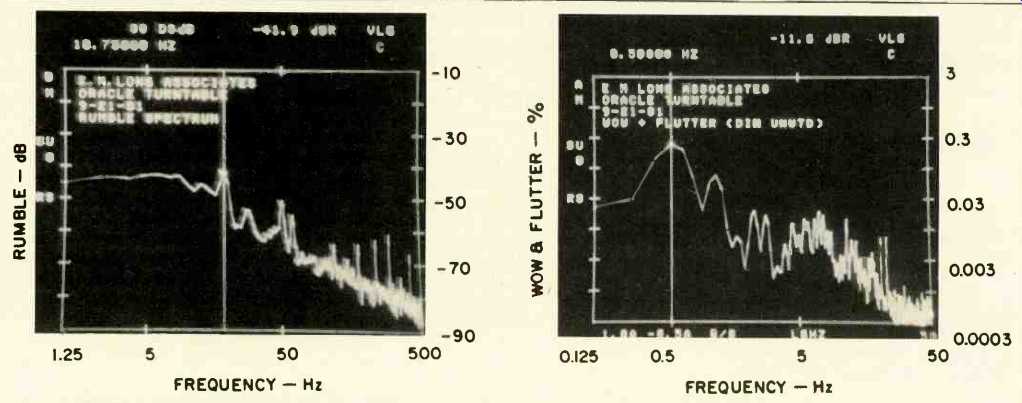
Fig.
4--Rumble spectrum, with most components below 20 Hz. Spikes are harmonics
of hum and occur below-60 dB. Resolution of spectral detail is excellent. (Note:
Unless noted, 0 dB ref. is 10 cm/S lateral groove modulation.)
Fig. 5--Wow and flutter spectrum from 0.125 to 50 Hz, with main wow at 0.5 and 1 Hz (see text). Wow at 7 to 10 Hz is probably caused by slight variations in tracking force due to tonearm resonance.
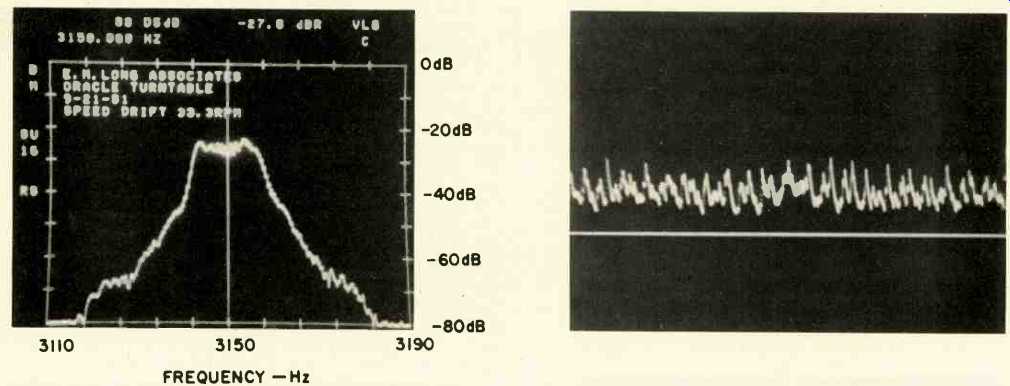
Fig. 6--Speed stability vs. time; shown is pitch variation. Stability was
calculated to be ±0.123% for a 20-second sample. (Horizontal scale is 8 Hz/div.)
Fig. 7--Speed drift vs. time. Note the cyclic variation of the 3150-Hz tone of Fig. 6.
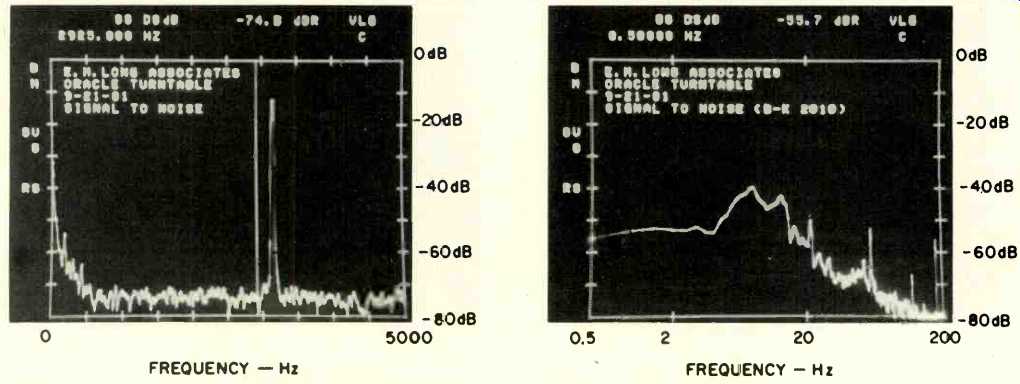
Fig. 8A--Spectrum of signal-to-noise ratio with 3150-Hz tone from B&K 2010
test disc. (Note: Scale is linear.)
Fig. 8B--As in Fig. 8A but from 0.5 to 200 Hz with log scale. Tonearm resonance is responsible for most of the increase from 7 to 10 Hz, but the level is over 40 dB down from the 10 cm/S reference.
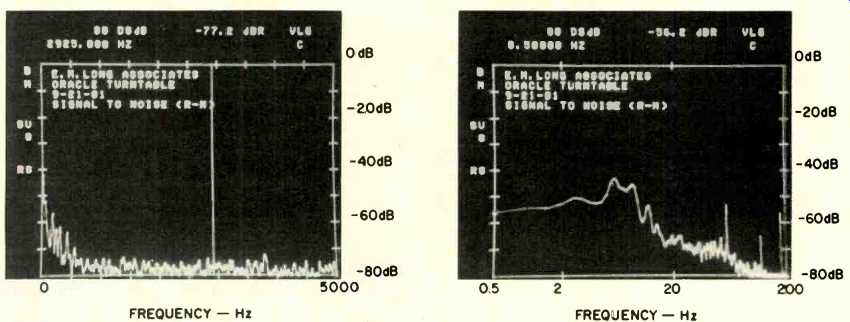
Fig. 9A--Similar to Fig. 8A but measured using Thorens Rumpelmesskoppler and
showing an even lower noise floor.
Fig. 9B--Similar to 8B but with the Rumpelmesskoppler. The arm resonance is still evident, but the spike at 20 Hz is not, indicating it is probably an artifact of the test disc.
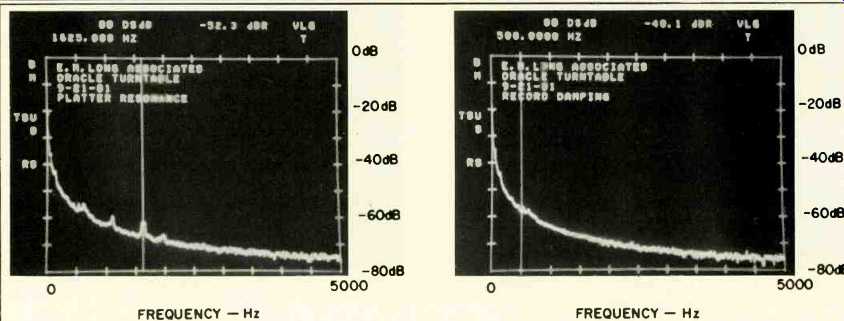
Fig. 10--Spectrum of platter resonance. See text.
Fig. 11--Spectrum of a record's internal resonances. See text.
(Source: Audio magazine, Mar. 1982)
Also see:
Oracle Premiere MK IV Turntable & Oracle SME 345 Tonearm (Apr. 1992)
Onkyo CP-1150F Turntable (Aug. 1981)
= = = =